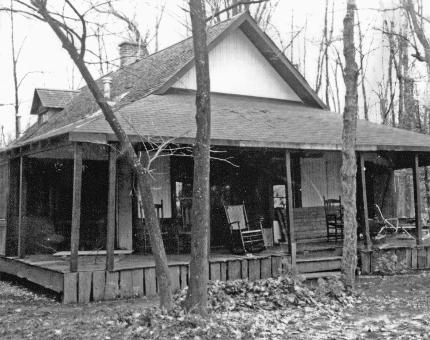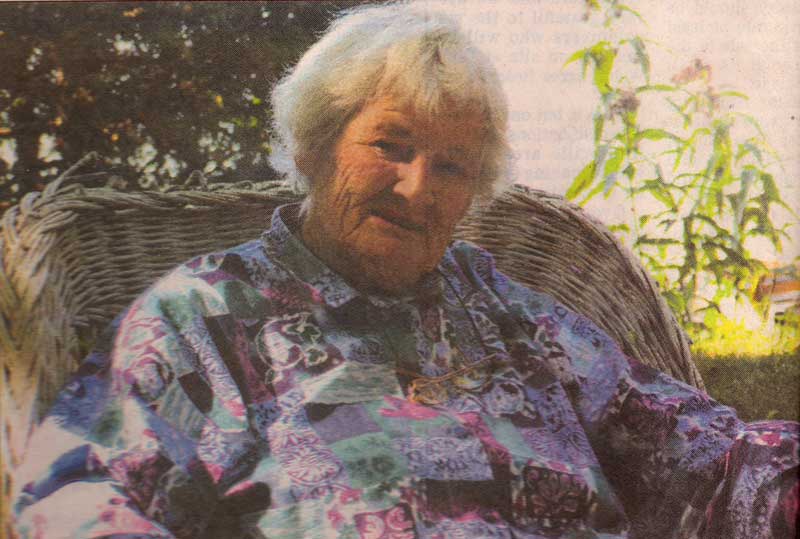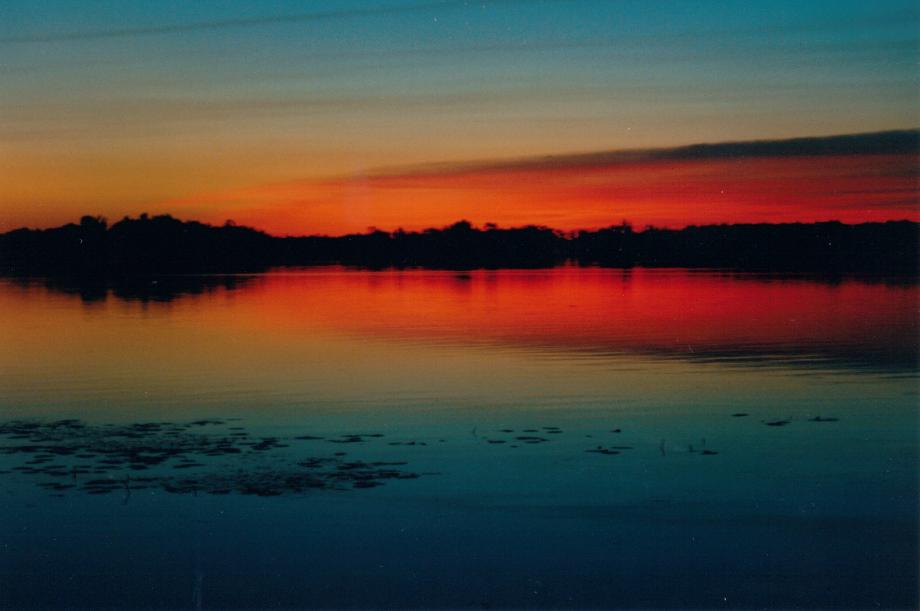They called it ‘Groundhog’
by Ralph A. Hunt
The other day I saw a groundhog in our back yard, probably the second sighting of one of these furry little animals in almost 70 years.
Why the sudden interest in groundhogs? This incident brought to mind fond memories of a magical place in Orillia, which stands out very vividly in the minds of a number of local residents who used to play on and around Couchiching Point, many years ago.
Photo taken by Alda McMahon on Couchiching Point in August 2012
Groundhog was the name of this place. I do not know the origin of the name. Perhaps it was inhabited only by groundhogs long ago. I can't recall whether the name was official or only coined by the local inhabitants, for whatever reason. In any event, the name Groundhog stands out very vividly in the minds of many older citizens today. I emphasize older, because the name no longer applies and the location has been bull-dozed in the name of real estate.
Magical? Yes! This was a place on the shores of Lake Couchiching which, if it could talk, would probably tell tales of Indian encampments, early explorers and give an historical review of the growth and development of this area.
As children we used to find shards of Indian pottery and occasionally an arrowhead, if we were very lucky. We were able to walk along the shore of the lake on a berm of land which maintained a great swamp on the land side and a marsh of magnificent proportions on the lake side. These areas harboured all forms of wildlife, an ideal spawning ground for fish and bull frogs and nesting areas for birds.
The marsh was so dense that we would have to pole a boat through the reeds in order to reach the other side. This was on the north side of Groundhog.
The south side was also a swamp, on the land side, and a dense marsh on the lake side. This precious point of Land protected on either side by marsh and forest and of course the strong prevailing west wind, projected out onto the lake and provided a landing point for any visitor.
This was the first land fall for Indians and explorers coming in off Lake Simcoe. After many weary hours of paddling one can envision these travellers passing through the Narrows between Lake Simcoe and Lake Couchiching and landing on the first piece of solid ground — silent and protected with an abundant supply of fish and wildlife.
The berms had to be man-made and probably provided protection in the event of an attack from the water.
The fish weirs in the Narrows probably were related to this area. Groundhog could have been the summer camp where the Indians would smoke their fish and enjoy the clear fresh waters of Lake Couchiching. Magical indeed! Historical, yes!
Groundhog and Couchiching Point lay dormant for many years, until a hotel was built on the end of the point. This hotel, the first big hotel north of Toronto, was constructed in 1871 by the Northern Railway. It catered to the wealthy people in Toronto and surrounding area.
A road was cut down the centre of Couchiching Point whereby the guests were transported from the railway station to the hotel. There was accommodation for 350 guests. It is interesting to note that Couchiching Point was then called Steamboat Point. The hotel was in existence a very short time when it was destroyed by fire, Oct. 5, 1876.
Once again Couchiching Point was quiet until Joseph Kilgour, the inventor of the square bottom paper bag, built a summer home on the site of the former hotel.
Mr. Kilgour, an ardent horseman would pasture a number of horses in the bush, which extended from the railway line to the end of the point, including Groundhog.
Time passed, commercial fishermen prospered on Lake Simcoe and Lake Couchiching. These fishing boats would anchor on the lee of Couchiching Point when great storms would rage in from the west. Some of their large anchoring stones rest in that area today.
Ice cutting was popular at the turn of the century and local residents would cut ice and store it using the sawdust collected from cutting their winter fire wood. Nothing was wasted. Survival was the name of the game.
Time passed, cottages sprang up on the west shore of Couchiching Point. The recreational hall and bowling alley from the hotel was converted into a residence for Mr. Kilgour's groundskeeper and maintenance man. This building exists today as a lovely home, as does Mr. Kilgour's old garage.
Couchiching Point lay quiet again with only one or two year-round residents. Cottagers were active from May 24 until Labour Day when everyone went home.
The '50s arrived and with them came developers with vision and of course the explosion of the motor boat.
Mr. Kilgour's summer estate burned down in 1959. Groundhog disappeared, canals were cut through the bush; roads, sewers and surveyors prevailed.
Slow growth and development ensued and today Groundhog is an extension of Glen Crescent. A beautiful home rests on the former site of Groundhog - the only remnant of that magical place is the magnificent view the residents enjoy as they look north on Lake Couchiching.
Boats of all sizes, shapes and noise scatter around the lake in search of quiet and solitude.
There are only a few cottages left on Couchiching Point. Suburbia has taken over. History has recorded the changes. Groundhog is just a faint memory of a few old timers.
The magic still remains.
Presently there are five generations visiting or living on Couchiching Point. It is interesting to note that each passing generation has found some of the magic that was created so many years ago.
Children laugh and play where once only silence prevailed. Except for the songs of birds and the crash of waves on the shoreline.
What is this magic which captures the imagination of each passing generation?
I am sure we all would have different explanations but they all would have taken root in places like Groundhog.
C. J. Lynde and the original CouchiCat
By Betsy Ramsay-Currie
In my opinion, my father, C.J. Lynda the Second, was smart.
He was smart enough to get a scholarship at Upper Canada College, he was smart enough to get his engineering degree from McGill University and he was smart enough to finish his doctorate. But most of all, he was smart enough to turn left off Atherley Road and drive down Couchiching Point to see if there were any interesting cottages for rent in the summer of 1948.

We were a family of five, my father, my mother, my sister, my brother and myself. We always had a relative or two living under our roof as well. My mother was just as generous as my father was smart. We all agreed that Lake Couchiching would be wonderful relief from the steamy summers in Toronto. We rented two different cottages in the first two years and the interesting thing about summers was that during July and August, my father became 'Dad’. Gone was the white collar, the sophisticated suit, the shiny shoes, the slick fedora and the colourful bow-tie. All were replaced by a bathing suit.
In 1950 we got the terrible news that there wasn't a cottage available. We were devastated. We had become accustomed to those weeks of holiday magic on Couchiching Point. My father had a solution: we would try to rent the 'Haunted House.'
The 'Haunted House' was a neglected cottage that was owned by a number of siblings with the surname Waugh. It was necessary to get all of them to agree to rent to us. No one had lived in the cottage for a number of years and before it had been boarded up, vandals had broken bottles inside and out. Pellet guns were used to take out articles placed on the mantle. There had even been an attempt to burn the place down but a bucket brigade had thwarted the vandals’ attempt.
I was nine years old that spring and the mere thought of trying to stay one night in bat-infested building was more than I could stand. My mother and my older sister were equally horrified at the mere thought of inhabiting that cottage.
But I suspect my younger brother had his bags packed immediately looking forward to the opportunity of co-habiting with raccoons, bats, and numerous mice. However we eventually all decided that staying there was better than not being able to summer on Broadview Avenue at all.
My father had to work a deal. He told the Waughs that he would like to rent the cottage year-round. He explained that as an engineer he would be able to fix up the place as we lived in it. The rent would be arranged according to the amount of improvements he could make during the summer months. He would list his accomplishments and then they would factor in the cash rent. Now he never promised expert workmanship! He just said he would list the improvements. (I told you he was smart). He seemed pretty sure that the landlords would never pay a visit.
The leasing papers were signed and we drove up early in the spring to see what extra furniture we might need. I'll never forget the first time my Dad tried to drive in the driveway. The grass was tall enough to block my view and any further progress the car would make. We waded through the vegetation and unlocked the door.
Aside from no electricity and no plumbing, the problem with the place was that they built one big central room containing a large brick fireplace. Then they added several additions for extra bedrooms and verandahs. That large brick fireplace I mentioned did not have any footings under it so it started to sink to the north and west. The chimney tried to take the central room with it and of course all the other additions got mixed up and started leaning every which way. We always told guests that a croquet ball could roll around for hours, powered by the different slants.
So once we opened that door, it wouldn’t shut again. Then we noticed that all the inside doors weren’t going to close because they couldn’t. The main room alone had seven doors.
My Dad started listing his improvements as the months went by. He said that he had built a dock but actually he had built a frame and used the shutters that weren’t needed in the summer.
He said that he had put electricity in the outhouse but actually just a bare bulb hung from the ceiling.
He said that he added door closers but actually he made a V shape with two boards and hung a rock in the centre. He said that he fixed the doors so they would fit but he actually just sliced off the bottom of each at the required angle.
Since the landlords never came to see the actual work, the rent remained reasonably low.
The low rent gave my Dad the extra cash to do what he really wanted to do: build a sailboat.
He made the three sections in the garage in Toronto and brought them up north to be assembled. He christened it the CouchiCat. Our family still believes his twin pontoon boat was on the water long before the later version and someone might owe him some patent rights The boat was rather heavy and as the winds of Lake Couchiching can be unpredictable he also had a trusty motor in the back.
One summer day, there seemed to be quite a commotion down by the shore so we all ran down to see what the excitement was all about.
A neighbour was towing the CouchiCat and my Dad, who was soaking wet and looking rather embarrassed. Apparently he had been having motor trouble and he decided to check if there was any gas in the tank. He used a match to check things out and blew himself off the back of the boat. Perhaps he wasn't as smart as I originally thought.
Lady of the Lake
Article by Courtney Whalen, The Packet & Times, published on Friday, September 28th, 2007, provided by daughter Dawn (Gzowski) Oxley
When Joy Gzowski (Manning) first started spending her summers on Couchiching Point as a little girl the closest thing to neighbours her family had were cows in the fields across from their property. Now, while the view out the front window of her home still shows the sun dappling off the water of Lake Couchiching, houses line the streets of the point.

"There were no houses, the only house was the white one which was the original dance hall and bowling alley on the point," she said, sitting in her home surrounded by cards wishing her well on her 90 birthday which she celebrated Sept. 15. "The whole point is citified now."
Her earliest memories of driving up from Toronto, where her father was a doctor, are when she was about three years old. Since then she said every summer has been spent at Couchiching Point, save one during the Second World War, before it became her permanent home in the 70s.
"It was a good time back then," she said. "We swam and we played baseball and we swatted mosquitos."
During the summer months her family stayed in a boathouse built by her uncles on her grandmother's property, which she said is still standing to this day.
Although her father would bring the family's 'tin lizzy' up to the cottage on the weekends, the main mode of transportation into Orillia was by boat.
"It was quite a row when it was rough," she said. "Every Monday we used to row the boat across, no matter what the weather, we'd row all the laundry across."
When asked if anything remains the same today Gzowski thinks about it a minute before answering.
"The hill," she laughs.
As a young girl Gzowski and her friends made their own fun. She recalls putting planks inbetween railway ties for a makeshift raft before a group would pile on and use an umbrella to catch the wind and push them down to the point. Once there they'd pick the raft up, carry it back and start all over again.
But she said one of her favourite things to do in the summer was get together for a corn roast.
"We used to have terrific corn roasts at Barnfield point," she remembers. "The whole point would come. Those were good, we all walked down or rowed our boats."
It was during one of her summer stays that her cousin Bruce introduced her to Casimir Gzowski, Cas to his friends.
"I guess he thought I was pretty neat ," she said.
After about five years the two were married when Gzowski was 23.
During the time before her marriage Gzowski worked for the Imperial Life Insurance Compnny for about three years, but still made the trip to Couchiching Point every weekend during the season. Taking the train into Orillia to be met usually by one of her cousins who rowed her across the lake to the point.
"I'd probably still be there now but Cas asked me to marry him," she said of the job.
Although the two, along with daughters Wendy and Dawn lived in Toronto, Couchiching Point, where Gzowski's mother now had her own cottage, remained their summer getaway.
"We all loved it here," she said.
Once her husband retired the couple moved up to the area permanently, eventually building an addition onto her mother's cottage after she died.
"We had 58 married years and we had the ups and downs, but everybody does, we had a good life," she said of her marriage.
These days, though her 90 birthday is just past Gzowski still keeps herself busy, swimming if the mood strikes her although she said she can no longer take the boat out because of difficulty hauling it back onto shore.
The bright red car she still drives sits in the driveway, but Gzowski still prefers to use her two feet. Although sometimes, like when she walks down to Just Eddie's for a bite she now uses a walker for added balance it doesn't deter her from walking.
"It's only about a mile or so," she said.
To celebrate her recent milestone Gzowski took a cruise on the Island Princess with family. With four grandchildren and four great-grandchildren Gzowski's home is filled with photos of family and 90 years of memories.
When she looks back on all her time spent on the shores of Lake Couchiching it still makes her smile.
"Sometimes I go to bed and I'll think of something we used to do way back then and I'll think, boy we used to have fun," she said.
For the Love of Nature
Tales from the Lee Side
by Larry Watson
This book is provided with the permission of Larry Watson, as obtained by Carole Watson. It is presented below in two parts.
NOTE: To return to the website when finished reading the selected part, click on the LEFT ARROW on the far left of the browser's menu bar above the document.

|
For the Love of Nature - part 1 of 2.pdf Size : 3116.692 Kb Type : pdf |

|
For the Love of Nature - part 2 of 2.pdf Size : 2614.154 Kb Type : pdf |

Photo by Larry Watson of the sunrise, looking north towards Fern Resort